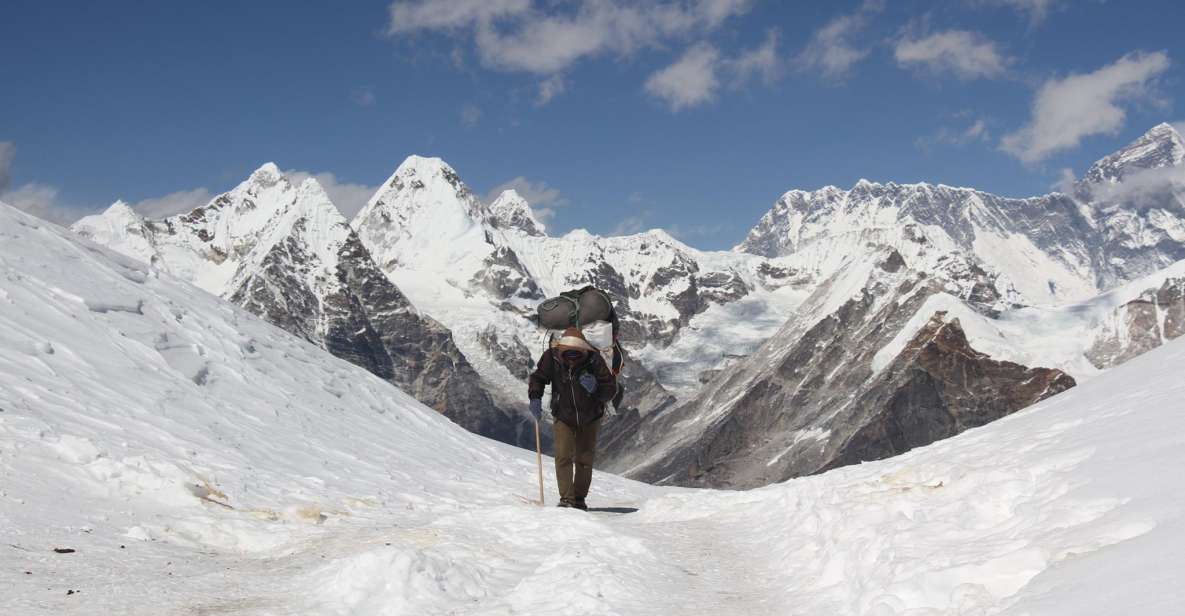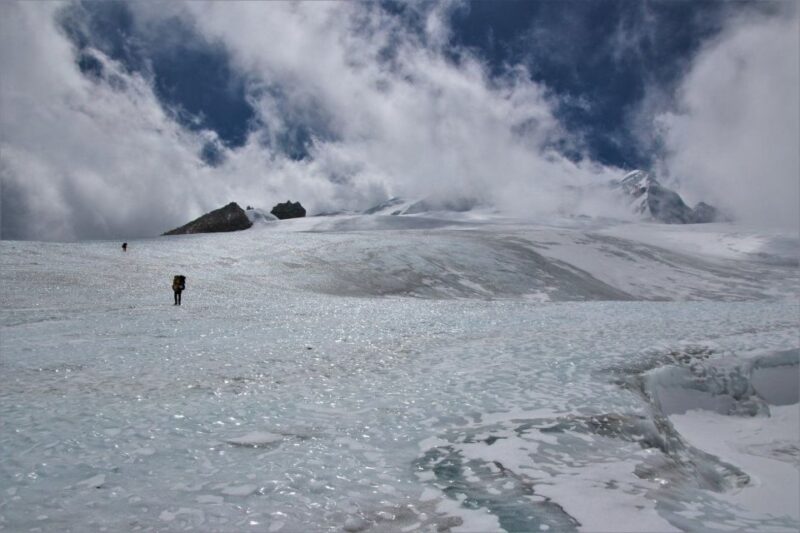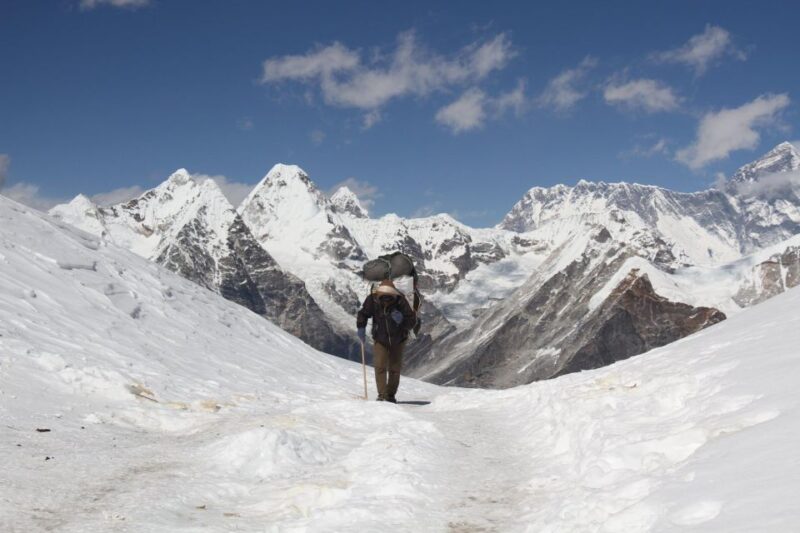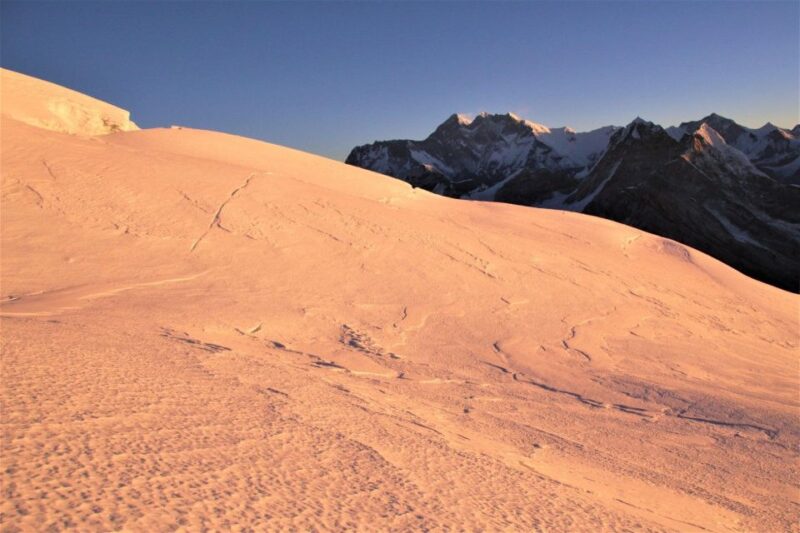Mera Peak Climbing is a captivating 14-day journey that offers adventure seekers the chance to conquer the majestic Himalayas, reaching a stunning height of 6,461 meters. With a well-structured itinerary that includes acclimatization days and expert guidance, climbers can focus on the thrill of the ascent without worrying about logistics. The trip is designed for those with reasonable fitness levels, ensuring a safe and fulfilling experience. But what should participants know before embarking on this remarkable adventure? The details that follow could make all the difference in preparing for the climb.
Key Points

- The Mera Peak climbing expedition spans 14 days, starting in Kathmandu and culminating at 6,461 meters.
- The itinerary includes acclimatization days to prepare climbers for the summit and ensure safety.
- Participants need decent fitness levels; the trek is not suitable for young children or those with serious health issues.
- The price starts at $2,075 per person, covering transfers, accommodation, meals, and group climbing equipment.
- Essential preparation includes layered clothing, quality footwear, and proper climbing gear, with rentals available locally.
Overview of Mera Peak Climbing

Mera Peak climbing offers adventurers a thrilling 14-day journey through the stunning landscapes of the Himalayas, culminating in a summit that stands at 6,461 meters. This expedition is perfect for those seeking an exhilarating challenge combined with breathtaking views.
Participants trek through lush valleys, rugged terrains, and charming villages, seeing the rich culture of the region.
With a price starting at $2,075 per person, the package includes airport transfers, accommodation, meals, and experienced guides to ensure safety and enjoyment.
Mera Peak climbing is designed for individuals with a decent fitness level, though it’s not suitable for everyone, such as young children or those with serious health issues.
It’s an adventure that promises unforgettable memories and a sense of achievement.
You can also read our reviews of more tours and experiences in Lukla.
Detailed Itinerary

Embarking on this 14-day adventure, climbers will follow a meticulously planned itinerary that balances challenging treks with opportunities for acclimatization and exploration.
Starting in Kathmandu, they’ll fly to Lukla before trekking through stunning landscapes to Chutanga, Thuli Kharka, and Kothe. Each day brings new heights, with a crucial acclimatization day at Khare to prepare for the summit push.
Climbers will then ascend to Mera High Camp, tackling the summit of Mera Peak on day nine. Following the summit, they’ll retrace their steps back to Lukla, savoring the journey as much as the destination.
A contingency day ensures flexibility, while the trip concludes with a return flight to Kathmandu and a farewell from Nepal.
Inclusions for Your Trip

Participants can look forward to a comprehensive package that covers everything needed for a successful and memorable climbing experience on Mera Peak. This journey ensures they’ve all the essentials to focus on their adventure without worrying about logistics.
Here are some key inclusions:
-
Airport transfers by private vehicles – hassle-free transportation.
-
Licensed high-altitude climbing leader – expert guidance throughout the climb.
-
Group climbing equipment – all necessary gear provided to ensure safety.
-
Food during the trek and climb – delicious meals to keep energy levels high.
With these inclusions, participants can enjoy the breathtaking landscapes while feeling secure and well-supported throughout their trek.
Exclusions to Consider
When planning a Mera Peak climbing adventure, it’s crucial to be aware of the exclusions that may impact the overall experience and budget.
Travelers should note that the cost doesn’t include a Nepal visa or international flights, which are essential for entry into the country.
Plus, while porters can be hired to carry luggage, this service is optional and not included in the base price.
Personal expenses, such as bar bills, beverages, and laundry, will also add to the budget.
Lastly, tips for climbing and trekking guides aren’t covered, so climbers should plan accordingly.
Being aware of these exclusions ensures a smoother and more enjoyable climbing experience.
More Great Tours NearbyPreparation and Packing Tips

Preparing for the Mera Peak climbing adventure requires careful planning and the right gear to ensure a safe and enjoyable experience. To help climbers pack efficiently, here are four essential items to consider:
-
Layered Clothing: Climbers should wear moisture-wicking base layers, insulating mid-layers, and a waterproof outer shell.
-
Quality Footwear: Sturdy, waterproof hiking boots with good ankle support are vital for trekking and climbing.
-
Climbing Gear: Essential items include crampons, an ice axe, and a harness, which can often be rented locally.
-
Hydration System: Staying hydrated is crucial; a hydration bladder or water bottles should be packed for easy access.
With the right preparation and packing, climbers can focus on enjoying their Mera Peak adventure.
Safety and Acclimatization

Safety and acclimatization play crucial roles in ensuring a successful and enjoyable Mera Peak climbing experience. Climbers need to be aware of altitude sickness, which can manifest with symptoms like headache and nausea. To minimize risks, the itinerary includes acclimatization days and gradual altitude increases.
Here’s a handy overview of safety measures and acclimatization tips:
| Safety Measures | Acclimatization Tips |
|---|---|
| Stay hydrated | Ascend slowly |
| Monitor symptoms regularly | Take rest days as needed |
| Rely on experienced guides | Eat high-carb meals |
| Use proper gear | Listen to your body |
Group Dynamics and Support
Effective group dynamics and strong support among team members are essential for a successful Mera Peak climbing expedition, fostering camaraderie and enhancing the overall experience.
Climbing in a group not only boosts morale but also helps individuals tackle challenges together. Here are four key aspects of group dynamics that make a difference:
-
Communication: Open lines encourage sharing concerns and celebrating achievements.
-
Mutual Support: Team members motivate each other, especially during tough stretches.
-
Shared Responsibilities: Dividing tasks enhances efficiency and builds trust.
-
Conflict Resolution: Navigating disagreements constructively strengthens bonds.
In a demanding environment like Mera Peak, these dynamics create an atmosphere where climbers can thrive, making their journey unforgettable.
Booking and Cancellation Policy
When planning a Mera Peak climbing adventure, it’s essential to understand the booking and cancellation policy to ensure a smooth experience. Participants can easily secure their spot with a deposit, while free cancellation is available up to 24 hours in advance for a full refund. This flexibility allows climbers to finalize their plans without stress.
Here’s a quick overview of the booking and cancellation details:
| Action | Policy | Notes |
|---|---|---|
| Booking | Requires a deposit | Confirm your reservation |
| Cancellation | Free up to 24 hours | Full refund available |
| Changes | Subject to availability | Additional fees may apply |
| Final Payment Deadline | 30 days before departure | Ensure timely payment |
| Contact for Issues | Customer service available | Reach out for assistance |
Frequently Asked Questions

What Is the Best Time to Climb Mera Peak?
The best time to climb Mera Peak is during spring (March to May) and autumn (September to November). These seasons offer stable weather, clearer skies, and more favorable conditions for trekking and summiting.
Do I Need Prior Climbing Experience for Mera Peak?
He doesn’t need extensive climbing experience for Mera Peak. Basic trekking skills and a good fitness level suffice, while the guidance of experienced Sherpas ensures a safe and enjoyable ascent for all participants.
How Do I Prepare for High-Altitude Trekking?
To prepare for high-altitude trekking, one should acclimatize gradually, build endurance through cardio workouts, stay hydrated, and practice hiking with a loaded backpack. A well-planned training regimen ensures a more enjoyable and successful trekking experience.
Are There Age Restrictions for Participants?
When it comes to age restrictions for participants, it’s important to note that children under 10 years aren’t permitted. Participants should also consider their fitness levels and any health conditions that might impact their experience.
What Should I Do in Case of Altitude Sickness?
When someone experiences altitude sickness, they should descend immediately, hydrate, and rest. If symptoms persist, seeking medical assistance is crucial. They shouldn’t ignore warning signs, as timely action can prevent serious complications.
Recap
Mera Peak Climbing offers adventure seekers an unforgettable journey through the stunning Himalayas, combining breathtaking views with the thrill of reaching 6,461 meters.
With expert guidance and all logistics taken care of, participants can focus on the climb and their personal achievements.
Whether you’re a seasoned climber or a passionate beginner, this expedition is an exceptional opportunity to challenge yourself, connect with fellow adventurers, and create lasting memories in one of the world’s most beautiful landscapes.
You can check availability for your dates here:More Tour Reviews in Lukla
Not for you? Here's more nearby things to do in Lukla we have reviewed
- Everest Heli Sightseeing Tour
- Mera peak trek
- Everest Base Camp Helicopter Landing Tour from TIA – 1 Day
- Everest Base Camp Trek – 6N/7D
- Nepal: Mera Peak Expedition with Trekking and Climbing
- Everest Scenic Mountain Flight (Review Exclusion Section)
- 16-Day Mera Peak Climbing Expedition
- 9 Best Tours In Lukla
- 24 Best Treks And Hiking Tours In Lukla
- 11 Best Helicopter Flights And Tours In Lukla
- Everest Base Camp Trek
- Kathmandu to Ramechhap Manthali Transfer – Sharing Vehicle
